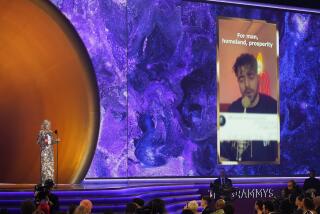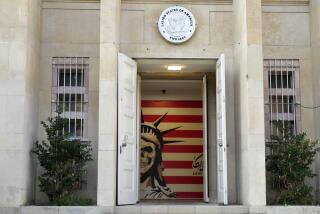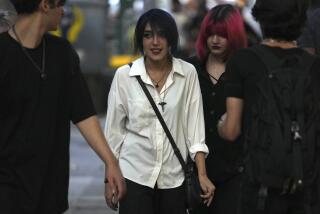Iran protests continue for fourth day
With titans of the Islamic Republic entrenched against each other, huge crowds of protesters clad in green and black pressed into President Mahmoud Ahmadinejad’s home turf Thursday to make the case that he won reelection through massive vote fraud.
The fourth day of demonstrations came as Iranians anticipated an address to the nation today by supreme leader Ayatollah Ali Khamenei at Friday prayers.
Despite his status, analysts said, Khamenei has little room to maneuver: There appears to be no constitutional mechanism to end Iran’s biggest political challenge in 30 years, and the nation’s factional politics have become a blood sport.
Dressed in black to mourn those killed in the clashes and green to mark their allegiance to rival candidate Mir-Hossein Mousavi, the protesters moved into traditionally conservative south Tehran, pouring out of a subway station into the vast Imam Khomeini Square.
Witnesses said they filed quietly through the Grand Bazaar, a vast labyrinth of shops and wholesalers that was once the nation’s economic nerve center.
Many shops were closed. But some workers in the district hung green fabric from balconies and windows or flashed victory signs in support of the protesters.
The Guardian Council, the nation’s constitutional watchdog, agreed to review specific complaints from Mousavi and two other candidates who ran against Ahmadinejad, but it has not broached the idea that the vote was rigged, a widespread belief among Mousavi supporters.
Analysts said the constitution provides no means for defusing the crisis. Neither is there the will to compromise among the hard-line faction that dominates Iranian politics or a precedent in the country’s winner-takes-all system.
“I don’t think they know what [compromise] means,” Anoush Ehteshami, an Iran expert at Durham University in Britain, said of the hard-liners.
“Does it mean annulment of the results?” he said. “Does it mean announcing Mousavi as the winner after all? Does it mean jailing Mousavi and his allies? Does it mean disbandment of parliament and a military government? All of these are still in the air. And indeed, for the leader to come and say we need to start again -- what a slap in the face of the conservatives!”
The unrest has left at least 12 people dead and led to the arrest of outspoken critics of the government.
The Assn. of Human Rights Activists in Iran says at least 32 people have been killed, but that number could not be confirmed. Protesters have clashed with members of the pro-government Ansar-e Hezbollah and Basiji militias.
Ahmadinejad appeared to make a slightly conciliatory gesture Thursday, clarifying comments from a speech he gave Sunday.
According to the Islamic Republic News Agency, he said his reference to “dirt” was meant to describe alleged vandals and arsonists, not those who voted against him. The statement had enraged many Iranians, who turned out for a massive rally Monday. Ahmadinejad said the news media misinterpreted his comments.
Within the establishment, moderate and reformist clerics and political figures are joining forces against Ahmadinejad and his hard-line factions.
“I am really worried,” said Mohsen Rezai, one of the three losing candidates and a former commander of the Revolutionary Guard. “In order to prevent a crisis from happening, our government, the candidates and our dear people have to do something.”
Authorities are continuing a widespread crackdown on dissidents and intellectuals they suspect of fomenting what they call a Western-backed “Green Wave.”
The Intelligence Ministry said it had “discovered and neutralized” enemy plots “guided by foreigners,” according to state television.
But the protesters are subtly fighting back with their own public relations tools. The black and green worn by demonstrators are the colors of the annual Ashura commemorations that mark the 7th century martyrdom of the grandson of the prophet Muhammad, who Shiite Muslims believe was robbed of his status as the leader of Islam.
Mousavi and his high-profile wife, Zahra Rahnavard, arrived at the south Tehran rally in two black SUVs, followed by motorcyclists wearing green bandannas and holding up victory signs, witnesses said.
At Enghelab Square, Mousavi left his vehicle and spoke to supporters, a witness said. According to news agencies, he accused state-controlled television of being one-sided in its descriptions of the recent protests and asked people to return to the streets Saturday.
“Tiredness equals defeat, endurance equals victory,” said a placard held up by one young man at Thursday’s protest, according to a witness.
Mahsa, a woman in her 20s waiting outside a subway stop in north Tehran, had a broken arm and bruises to her face, which she said she suffered at the hands of Basiji militiamen who stormed her neighborhood during the recent nights of unrest.
But she said she was heading to the rally on the south side anyway.
She had painted her cast green, despite a news report that pro-government vigilantes on motorcycles were preparing to patrol the march.
Khamenei, the supreme leader, was expected to address the election issue during his highly anticipated sermon at Friday prayers. In a massive show of support for the cleric’s authority, a huge crowd is expected to attend, including officials who will fly in from around the country and Basiji militiamen who will be bused in.
But analysts said there were few options for quickly quelling the massive discontent. If Khamenei decides to side with Ahmadinejad, the constitution provides no mechanism for appeal. The supreme leader is considered God’s representative on Earth under Iran’s complex political system, which combines elements of a republic with a theocracy.
In the unlikely event that Khamenei calls for a new election, he would betray his own political base, including the Basiji militiamen and their families and social networks that are his core supporters. Those same networks adore Ahmadinejad.
“I believe he’s going to refuse or reject the demand for new elections,” said Alireza Nourizadeh, an Iran analyst in London. “And after that, well, that’s actually the statement for a confrontation.”
One possible compromise would be for Ahmadinejad to offer Mousavi a few key Cabinet posts, giving both sides a face-saving way to declare victory.
But the factional politics that have bedeviled Iran since the founding of the Islamic Republic in 1979 may prevent that. Few expect Ahmadinejad or other hard-liners who have spent a decade fighting back a reformist tide to suddenly compromise. It’s not certain that Mousavi, a former prime minister, would accept it either.
“At this point, both sides think they must go ahead as long as it requires,” Nourizadeh said.
The government could also try to wait until the young people, the driving force behind the protests, get tired or bored and their ranks thin out enough for officials to use blunter instruments of state. Some say similar protests in other Iranian cities have already petered out or been quashed by violence.
But protesters insist that it’s just a matter of time before the other cities rejoin the fight, and there are many signs that the young are still brimming with energy.
“They broke my arm and I keep going,” said Mahsa, the young protester. “Why should I be afraid of going down there? They come to our neighborhood too, and we’re not afraid of them there either.”
--
Mostaghim is a special correspondent.
More to Read
Start your day right
Sign up for Essential California for news, features and recommendations from the L.A. Times and beyond in your inbox six days a week.
You may occasionally receive promotional content from the Los Angeles Times.






